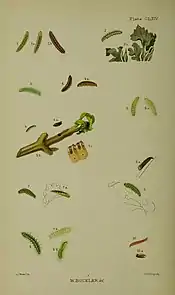Merrifieldia baliodactylus
Merrifieldia baliodactylus, also known as the dingy white plume, is a moth of the family Pterophoridae found in most of Europe. It was first described by the German entomologist, Philipp Christoph Zeller in 1841.[1]

Fig. 8 larva after final moult 8a pupa
| Merrifieldia baliodactylus | |
|---|---|
.jpg.webp) | |
| Scientific classification | |
| Domain: | Eukaryota |
| Kingdom: | Animalia |
| Phylum: | Arthropoda |
| Class: | Insecta |
| Order: | Lepidoptera |
| Family: | Pterophoridae |
| Genus: | Merrifieldia |
| Species: | M. baliodactylus |
| Binomial name | |
| Merrifieldia baliodactylus (Zeller, 1841) | |
| Synonyms | |
| |
The wingspan is 20–27 millimetres (0.79–1.06 in). Adults are on wing from July to August in one generation in western Europe.[2]
The larvae feed on Oregano (Origanum vulgare), biting through the stem and causing the upper leaves to wilt.[3]
References
- "Merrifieldia baliodactylus (Zeller, 1841)". Fauna Europaea. Retrieved 30 July 2020.
- Kimber, Ian. "Merrifieldia baliodactylus (Zeller, 1841)". UKmoths. Retrieved 30 July 2020.
- Ellis, W N. "Merrifieldia baliodactylus (Zeller, 1841) dingy white plume". Plant Parasites of Europe. Retrieved 30 July 2020.
This article is issued from Wikipedia. The text is licensed under Creative Commons - Attribution - Sharealike. Additional terms may apply for the media files.